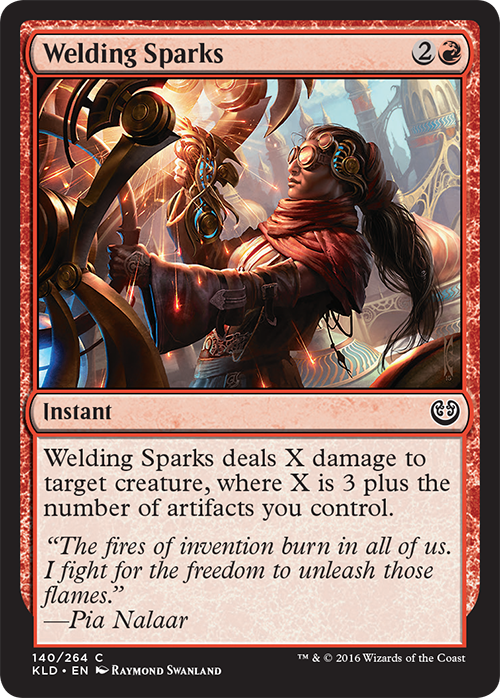A First Glimpse at Magic: The Gathering—Kaladesh

I have covered the wide breadth of Magic: The Gathering events. I have traveled to the grand halls of the Grand Prix in order to test my mettle against the brutalizing skills of the enthusiast meatgrinder player. I have nestled into the silent quarters of the Pro Tour to watch the best players in the world gesture, grunt and shuffle their way to victory. And now I have traveled to the ancient and arcane sanctum known as the Paramount Theatre, enveloped in the gravity field of PAX West, to learn about the new set, Kaladesh, which is out September 30th.
Each set in Magic takes place on a different plane of the multiverse, which is just to say that the game loves to take us to different worlds that each have different mechanics, narratives and physical descriptions. For example, New Phyrexia is a world of living metal poisoned by an evil oil that has warped many of its denizens into steely organic murdermachines; Ravnica is a world covered in a city coveted and controlled by a guild system guided by the principles of the different colors of mana. The capabilities of Magic’s creative team when it comes to designing new worlds has always been astonishingly broad (I have, to either extreme shame or extreme pride, even read the comic books from the early 1990s), but the past year has been dominated by “return” sets where the game has traveled back to worlds we’ve seen before. Last fall we saw the Gatewatch finally defeat the eldrazi titans in the Battle for Zendikar, and earlier this year we witnessed the Shadows of Innistrad grow and then recede when the final titan was defeated in a world of werewolves and vampires.
For the most part, Kaladesh is brand new for Magic. We received some hints about the plane in the 2015 set titled Magic Origins, a kind of prelude that contained the prequel stories of several planeswalkers that have now come together to make up the magical wizard supergroup called the Gatewatch. It’s the home plane of Chandra Nalaar, the walking billboard for the qualities of red mana (read: magic): she’s quick to anger, quick-witted, and also has a deep love of pyromancy.
The world of Kaladesh is powered by two things: aether and the people who harness it. Aether is, as world design team member Jeremy Jarvis explained on stage, “the mayonnaise of the universe.” When planeswalkers walk the planes, they are traveling through that lite mayo to get to their destinations. Most planes are fundamentally cut off from direct access to the aether, but Kaladesh is unique in that it has an aethersphere (mayosphere?) around it that the denizens of the world have figured out how to tap. That means they have lots and lots of energy to play around with.
This has fundamentally impacted the ecology of Kaladesh and rendered the plane unique. The mountains, plants and structures of the world all bend toward the sweeping, curling form that aether takes, and it leads to a much more stylized and unique visual assemblage than other planes. This might be the appropriate time to say that the Kaladesh leans very hard into the visual stylings of a fantastical, precolonial India (as one of the set’s key characters, Saheeli Rai, might suggest). While I can’t speak to how successful they have been at synthesizing the cultural references with the fantasy elements, my general impression is that the gesture toward Indian culture is just that: a vague gesture. I’ve yet to see a card that really felt like it “landed” in that cultural space.
At the same time, Magic has gotten better and better at melding the mechanical elements of the game with the narrative ones, and Kaladesh is the best that this current formation of the company has done so far. The narrative framework of the new set rests on an Inventor’s Fair where creatives from around the world come to a central location in order to invent as much as they can with the aether provided by the vague government structure of Kaladesh. Sitting in the front row of the mechanics announcement, I could literally hear Mark Rosewater, who co-lead concept design of the set with Shawn Main, hollering with delight about what they had come up with.
